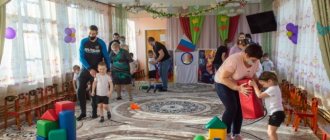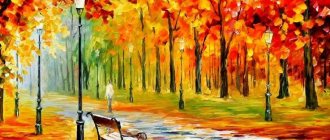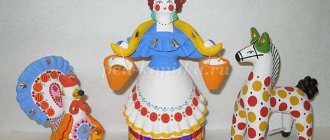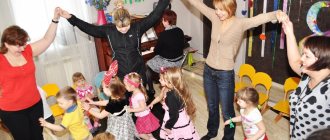Theatrical classes in kindergarten outline of a drawing lesson (senior group) on the topic
Municipal state preschool educational institution
"Kindergarten No. 229" compensatory type
Summary of an integrated lesson in visual arts for children of senior preschool age “making a poster for the premiere of the play”
Performed:
Miller
Tatyana Alekseevna
Novokuznetsk
2013
Software tasks.
- Introduce children to the concept of “poster”, a schematic sketch of the composition of the poster.
- Combine different types of inventive activities of children to perform joint work.
- Form the idea that the overall result depends on the work of everyone.
- Activation of the dictionary: poster, sketch, premiere.
Materials and equipment: sample poster, sketch of the poster, 5 photographs of children participating in the fairy tale, 5 stencils of the fairy tale characters, letter templates, paints, pencils, felt-tip pens for drawing the characters’ figures; scissors, glue, napkins, a sheet of Whatman paper.
Progress of the lesson.
The teacher seats the children in subgroups (5 people each) at tables with prepared material.
— Soon the premiere of the fairy tale “Cat’s House” will take place in our kindergarten. Who knows what a “premiere” is? (children's answers)
— How can viewers find out which fairy tale they will watch, on what day and time? How do you find out when theater tickets are distributed? (children's answers)
(If the children themselves say that there is such a way of informing viewers as a poster, then the teacher continues the thought. If the children find it difficult, then the teacher begins work by showing a sample poster, i.e. introduces the children to the features of the poster).
“The brighter and more interesting the poster is, the more people will notice and read it and, of course, want to watch the fairy tale.”
“Let’s all make a poster for our theater today.” So that you know what our poster will look like, I will show you a sketch of it. A poster sketch is a diagram of how the inscriptions and drawings of the poster will be located.
(Shows the children the sketch and gives them time to familiarize themselves.)
-What did you learn from this sketch? What do you think will be shown in the middle of the poster? (inscription). What will happen around? (portraits of artists with completed figures of fairy tale characters).
- Today you will each do your own work. But when you and I combine the results together, we will get one piece of work - a theater poster. To make the poster colorful and bright, everyone must do their part, how? Of course, carefully, without rushing and always to the end.
- Look at what material is on your table, and from it you will find out what each group will do for the poster.
(It is once again clarified what each subgroup of children will do. Then they are asked to start working.)
Methodical instructions.
As they work, children cutting out portraits from photographs are given advice on how to cut out carefully and so that the face is completely exposed. Paste the photo in the location indicated on the sheet.
Other children are given advice on how to cut out and paint a figure for the portrait of the “artist”.
Children working with letter templates are reminded to trace the letters very accurately, right at the edge, holding the pencil vertical to the paper. Then carefully cut along the line with scissors.
When everything is ready for decoration, two tables are moved, a sheet of whatman paper is placed, and according to the sketch, the teacher, together with the children, places all the figures and letters.
It is better to start designing a poster by gluing figures, then portraits to the figures, and then letters. The teacher helps children distribute work among themselves using directions, counting rhymes and other techniques.
In conclusion, they examine the poster and discuss whether it can attract the attention of parents and children (children’s opinions are listened to, with the obligatory recording of the words “poster”, “premiere” in their answers).
On the topic: methodological developments, presentations and notes
Summary of a drawing lesson in the preparatory group on the topic: “Baby caterpillar” (drawing with wool).
Goal: Drawing indoor plants: sansevieria and speckled begonia from life.
Abstract of the GCD “On the Seabed”.
Visual tasks: - Learn to draw indoor plants from life. - Correctly convey the structure of two.
With the help of paintings by great artists, develop the child’s imagination and spiritual world. Develop thinking and creativity. Understanding the world around us through works of art.
Topic: Drawing indoor plants from life.1. Program content: Purpose: Drawing indoor plants: sansevieria and speckled begonia from nature. Tasks.
Summary of a drawing lesson in a preparatory group using non-traditional types of drawing on the theme “Bouquet for a beloved mother.”
Source
Preparatory group. Senior preschool age. Children 6-7 years old
Synopsis of a puppet theater performance based on the fairy tale “The Fox and the Hare” for children of senior preschool age with NODA Synopsis of a puppet theater performance based on the fairy tale “The Fox and the Hare”
for children of senior preschool age with musculoskeletal disorders.
Goal: Introducing children to theatrical activities Objectives : 1) Introduce children to a new fairy tale.
2) Improve the ability... Lesson summary for children of the preparatory group “Getting to know the theater” Goal: supporting the cognitive and creative initiative of children, creating conditions for the artistic and aesthetic development of children through familiarization with theater as an art form. Objectives: to introduce children to the concept of “ theater ”
;
introduce children to the types of theaters ...
Master class in the preparatory group “Making characters for tabletop theater”
Irina Lipatova
Master class in the preparatory group “Making characters for tabletop theater”
Purpose: making characters for tabletop theater (shadow and finger)
Educational: learn to cut out images of characters along a drawn outline, strengthen the ability to carefully work with scissors and skewers.
Developmental: develop a sustainable interest in theatrical and gaming activities ; develop fine motor skills, imagination, fantasy, and speech skills.
Educational: cultivate independence, accuracy, patience, ability to work in a team; desire to create crafts with your own hands.
Templates of characters from the fairy tale “Little Red Riding Hood”
(
table theater , character templates from the fairy tale “Teremok”
(shadow
theater , scissors, tape, skewers.
Preview:
Topic: "Ticket to the theater".
- develop the ability to draw with gouache; convey in the drawing the features of the appearance of animals;
- develop imagination and perception of the surrounding world;
– cultivate accuracy during work.
Vocabulary work: ticket, theater.
Methods: visual, verbal, practical.
Materials: pictures depicting a fox, a hare and a rooster; flannelgraph, brushes, paints, strips of paper with the inscription “ticket” for each child, stands for brushes, cups for water.
Pictures depicting a fox, a hare and a rooster are hung on the flannelgraph.
- Hello guys. I want to invite you to the theater again. Look at the board, who do you see?
Guys, are the fox and the hare wild animals or domestic ones? Is a cockerel an animal or a bird? That's right - it's poultry. Guys, despite the fact that these animals are so different, they still met in the same fairy tale. Now I’ll start telling you this fairy tale, and you try to guess what it’s called? That's right "Zayushkina's hut". Guys, this week we are all invited to a performance based on this fairy tale. Remind me what the audience must have to get into the auditorium? (tickets) . Of course tickets. But the problem is, the box office has already closed and now you can’t get tickets. How to be? How else can we get tickets? (draw). That's right, before we start drawing, let's play.
The fox is walking across the bridge - Children are stamping their feet
Carrying a bundle of brushwood - They pretend to carry a weight on their back
- Heat the stove - Movement of hands from side to side
— Cook dinner — Circular movements with hands
— Feed guests — Bend forward
And the bear come, and the wolf come, and the hare come, and the rooster come!
- Oh please! - end of the game.
- What a hospitable Fox!
Now let's go to the tables and take care of our tickets. (Children sit down). Guys, what are we going to draw on them? Of course, we will draw our fairy-tale heroes on them. Someone will draw a bunny, someone a fox, and someone a cockerel, and someone might want to draw them all together? Let's get to work, and don't forget that our animals should be the same color as they really are (children draw).
- Well done, guys, what beautiful and bright tickets we got. I think that there will be many guests in our theater. Well, I'm waiting for you at the performance!





